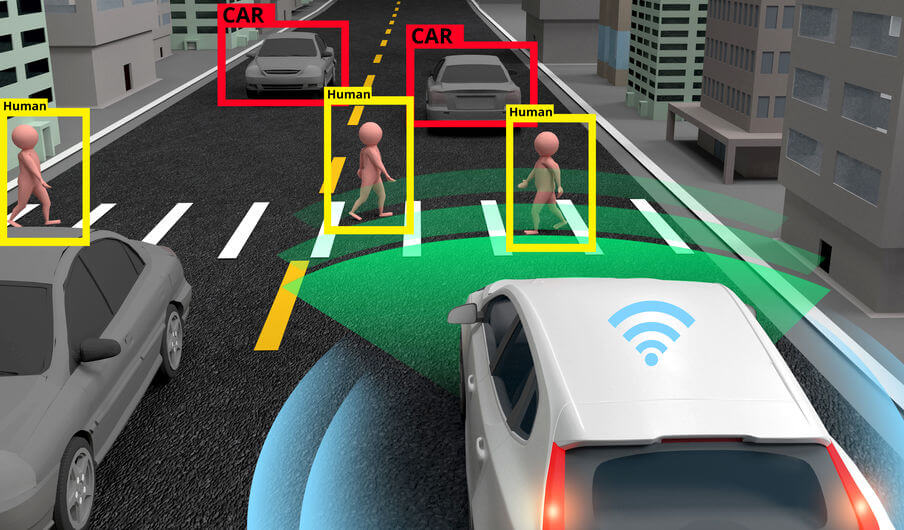【自动驾驶中的图像识别】:技术挑战与最新进展
发布时间: 2024-09-06 12:40:01 阅读量: 308 订阅数: 110 


图像识别技术的进展和应用.pdf

# 1. 自动驾驶与图像识别基础
自动驾驶技术的发展离不开图像识别,它为汽车提供了一双能够“看懂”周围环境的眼睛。本章旨在为读者提供自动驾驶和图像识别基础的概览,以便更好地理解后续章节中更为专业和深入的内容。
## 1.1 自动驾驶与图像识别的交融
自动驾驶汽车依靠多种传感器收集周围环境的数据,图像识别技术在这些传感器中占据核心地位。通过安装在车辆上的摄像头,可以捕捉实时视频流,这些图像数据为汽车提供了识别其他车辆、行人、交通标识和道路情况的能力。
## 1.2 图像识别技术的重要性
图像识别技术让自动驾驶系统可以有效地理解视觉信息,并且做出安全和正确的决策。无论是识别障碍物以避免碰撞,还是解读交通灯的变化以调整行驶速度,图像识别都发挥着不可或缺的作用。
为了实现可靠的自动驾驶,图像识别算法需要处理各种天气条件和光照变化所带来的影响,并且必须拥有高速处理图像数据的能力以满足实时性要求。这些挑战推动了图像识别技术的快速发展。
通过理解这些基础概念,读者将为学习后续章节中更高级的图像处理、机器学习和深度学习技术打下坚实的基础。
# 2. 图像识别技术的理论基础
## 2.1 图像处理的基本概念
### 2.1.1 图像的数字化和表示方法
数字化是将现实世界的图像转换成计算机可以处理的格式的过程。在数字化的过程中,我们通常使用位图(raster)图像,它由一系列称为像素的小单元组成。每个像素都有特定的位置和值,通常是颜色值,用数字表示。在数字图像中,最简单的表示方法是使用二值化,即只有黑白两种颜色。更复杂的图像则使用灰度值,即从黑色到白色的连续色调。最常见的彩色图像表示方法是RGB模型,它通过红色、绿色和蓝色光的强度组合来创建其他颜色。
代码块演示了如何在Python中使用Pillow库来创建和保存一个简单的数字化图像:
```python
from PIL import Image, ImageDraw
# 创建一个新的白色图像
width, height = 100, 100
image = Image.new('RGB', (width, height), 'white')
# 创建绘图对象
draw = ImageDraw.Draw(image)
# 在图像上绘制一个黑色方块
draw.rectangle([30, 30, 70, 70], fill='black')
# 保存图像
image.save('digital_image.png')
```
在上述代码中,我们首先导入了Pillow库的相关模块。然后,我们使用`Image.new`函数创建了一个新的图像对象,该对象是一个100x100像素的白色图像。接下来,我们创建了一个绘图对象`draw`,它允许我们在这个空白图像上绘制。我们使用`draw.rectangle`方法在图像上绘制了一个黑色的方块,指定方块的左上角坐标为`(30, 30)`,右下角坐标为`(70, 70)`。最后,我们使用`image.save`方法将图像保存到磁盘上。
### 2.1.2 图像的增强与滤波技术
图像增强是图像处理中的一个重要领域,用于提高图像质量或改善视觉效果。通过图像增强技术,我们可以强化图像中的某些特征,例如对比度和亮度,或者应用滤波技术来减少图像噪声或者突出图像中特定的结构。常见的图像增强方法包括直方图均衡化、图像锐化、平滑滤波、边缘检测等。
以下是一个使用直方图均衡化增强图像的例子:
```python
from PIL import Image, ImageEnhance
# 打开原始图像
original_image = Image.open('original_image.jpg')
# 应用直方图均衡化
enhanced_image = ImageEnhance.Contrast(original_image).enhance(1.5)
# 保存增强后的图像
enhanced_image.save('enhanced_image.jpg')
```
在这个代码示例中,我们首先打开了一个名为`original_image.jpg`的原始图像。然后我们使用`ImageEnhance.Contrast`来获取一个增强器对象,通过调用该对象的`enhance`方法并传入一个值(此处为1.5),我们增强了图像的对比度。最后,增强后的图像被保存为`enhanced_image.jpg`。
### 2.1.3 图像滤波与去噪
图像滤波是处理图像噪声的过程,目的是改善图像质量。滤波通常涉及对图像中每个像素应用一个窗口(即局部邻域)上的函数。常见的滤波算法包括均值滤波、高斯滤波和中值滤波等。
以下是一个使用中值滤波去噪的代码示例:
```python
from PIL import Image, ImageFilter
# 打开带噪声的图像
noisy_image = Image.open('noisy_image.png')
# 应用中值滤波
filtered_image = noisy_image.filter(ImageFilter.MEDIAN_FILTER)
# 保存去噪后的图像
filtered_image.save('denoised_image.png')
```
在该代码段中,我们首先加载了一个带噪声的图像。接着,我们使用`Image.filter`方法和`ImageFilter.MEDIAN_FILTER`参数应用中值滤波器。中值滤波器将每个像素的值替换为其邻域内像素值的中位数,这种方法对于去除图像中的随机噪声非常有效。最终结果被保存为`denoised_image.png`。
## 2.2 机器学习在图像识别中的应用
### 2.2.1 机器学习模型概述
机器学习是人工智能的一个分支,它使计算机系统能够从数据中学习并改进性能。机器学习模型通常分为监督学习、无监督学习、强化学习和半监督学习等。在图像识别任务中,最常使用的是监督学习,其中包括分类器和回归模型。
在监督学习中,训练数据包含输入特征(图像)和相应的输出标签(类别)。模型通过最小化预测误差来学习映射关系。一旦训练完成,模型就可以用来对新的图像进行预测。
以下是使用Scikit-learn库实现简单线性回归模型的示例代码:
```python
from sklearn.linear_model import LinearRegression
from sklearn.metrics import mean_squared_error
import numpy as np
# 创建示例数据
X = np.array([[1], [2], [3], [4], [5]])
y = np.array([1, 2, 3, 4, 5])
# 创建线性回归模型
model = LinearRegression()
# 训练模型
model.fit(X, y)
# 使用模型进行预测
predictions = model.predict(X)
# 计算均方误差
mse = mean_squared_error(y, predictions)
print(f'Mean Squared Error: {mse}')
```
在这个例子中,我们首先导入了`LinearRegression`模型和`mean_squared_error`函数。然后,我们生成了一个简单的线性数据集,并将其转换为NumPy数组。我们创建了`LinearRegression`实例,并使用`.fit()`方法训练了模型。模型训练完成后,我们用训练数据本身进行预测,并计算了预测结果与真实值之间的均方误差,以评估模型性能。
### 2.2.2 训练集与测试集的划分
在机器学习中,数据被分为训练集和测试集,用于训练模型并验证其性能。划分数据集的目的是评估模型在未知数据上的泛化能力。常用的划分比例是80%的训练数据和20%的测试数据,但这一比例可以根据数据集的大小和需要进行调整。
以下是如何在Python中使用Scikit-learn库来划分数据集的示例:
```python
from sklearn.model_selection import train_test_split
import numpy as np
# 假设X是特征矩阵,y是标签向量
X = np.array([...]) # 特征数据
y = np.array([...]) # 对应的标签数据
# 将数据集划分为训练集和测试集
X_train, X_test, y_train, y_test = train_test_split(X, y, test_size=0.2, random_state=42)
# 训练集用于模型训练,测试集用于模型性能评估
```
在这段代码中,我们首先导入了`train_test_split`函数。然后,我们使用该函数对特征矩阵`X`和标签向量`y`进行划分。通过`test_size=0.2`参数,我们指定20%的数据作为测试集。`random_state`参数用于确保每次划分的结果都是一致的,方便结果的复现。
### 2.2.3 模型评估与选择
模型评估是机器学习过程中的关键环节,涉及到选择最佳模型的过程。常见的评估指标包括准确率、召回率、F1分数、ROC曲线和AUC值等。在实践中,模型的选择通常基于交叉验证的分数,这可以减少过拟合的风险,并提供模型泛化能力的更真实估计。
以下是一个使用交叉验证选择最佳模型的例子:
```python
from sklearn.model_selection import cross_val_score
from sklearn.svm import SVC
from sklearn.datasets import load_iris
from sklearn.pipeline import make_pipeline
from sklearn.preprocessing import StandardScaler
# 加载数据集
iris = load_iris()
X, y = iris.data, iris.target
# 创建一个管道,包括预处理(标准化)和分类器(支持向量机)
clf = make_pipeline(StandardScaler(), SVC())
# 使用交叉验证来评估模型性能
scores = cross_val_score(clf, X, y, cv=5)
# 输出交叉验证分数
print(f"Accuracy scores for each fold: {scores}")
print(f"Average accuracy: {scores.mean()}")
```
在这个代码示例中,我们首先加载了鸢尾花数据集。然后,我们创建了一个管道,该管道首先使用`StandardScaler`对数据进行标准化处理,然后使用支持向量机`SVC`作为分类器。我们使用`cross_val_score`函数,通过5折交叉验证来评估模型的性能。最后,我们输出每折的准确率以及平均准确率。
## 2.3 深度学习技术突破
### 2.3.1 卷积神经网络(CNN)原理
卷积神经网络是深度学习领域用于图像识别的重要架构。CNN通过使用卷积层自动从图像中学习空间层次结构。每一层的神经元只与前一层的一个局部区域相连,并提取局部特征。经过多层卷积和池化层后,CNN能够捕捉更高级的特征,从而用于图像分类、目标检测等多种任务。
下面是卷积神经网络的简要架构示意图:
```mermaid
graph LR
A[输入图像] -->|卷积层| B[特征提取]
B -->|池化层| C[特征降维]
C -->|全连接层| D[分类决策]
```
在这个简化的CNN架构中,输入图像首先经过卷积层提取特征,然后通过池化层减少特征的维度,最后通过全连接层输出分类结果。
### 2.3.2 转移学习与预训练模型
转移学习是一种机器学习方法,它允许我们将从一个问题学到的知识应用到另一个相关问题上。在深度学习中,预训练模型是一个在大型数据集上预先训练好的模型,它可以作为起点应用到新的任务中,这可以显著减少所需的数据量和训练时间。
Keras库中的预训练模型例子代码:
```python
from tensorflow.keras.applications import VGG16
from tensorflow.keras.models import Model
from tensorflow.keras.layers import Dense, Flatten
from tensorflow.keras.preprocessing.image import ImageDataGenerator
# 加载预训练的VGG16模型,不包括顶部的全连接层
base_model = VGG16(weights='imagenet', include_top=False)
# 添加新的全连接层作为分类器
x = Flatten()(base_model.output)
x = Dense(256, activa
```
0
0





